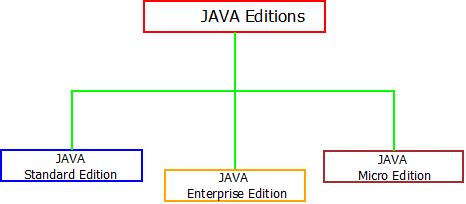Overview Of Java : History
- Hello geeks, this is a basic Java tutorial which will cover the overview of java and will provide you with enough concepts and examples to head to advanced Java concepts.
- Java is a high-level, general purpose, object-oriented programming language that is much robust to handle today’s software requirements.
- Project Java was initiated by James Gosling, Patrick Naughton and Mike Sheridan which was initially named Oak. Afterwards, it was renamed to Java , from Java coffee (ever noticed Java logo).
- In 1995, Sun Micro-systems Inc. released the first ever version Java 1.0 .
- Other Java versions released later and till date are :
- JDK 1.1 (1997)
- J2SE 1.2 (1998)
- J2SE 1.3 (2000)
- J2SE 1.4 (2002)
- J2SE 5.0 (2004)
- Java SE 6 (2006)
- Java SE 7 (2011)
- Java SE 8 (2014)
- Java SE 9 (2017)
Overview Of Java : Java Editions
- The main purpose of java initially was to create and handle software needs for Set-top boxes, washing machines, refrigerators and other equipment. But today Java is also used to develop client side standalone applications, Android apps, mobile apps(based on Java), embedded systems, games, web apps etc.
- There are the 3 main Java editions. Other new editions include Java Fx ( used to provide rich GUI experience in applications) , Java Card ( aimed to provide environment for applications that run on smart cards such as ATM cards) etc.
- Let’s discuss the 3 main editions of Java :-

Overview Of Java : Editions
-
Java SE
- This is known as Java Standard Edition and is the most commonly used among all of these editions. This is Mainly used to develop desktop applications because of its ability to supports the use of applet programming and can be uses to create applets and embed them in web pages.
- It’s the most basic version of Java, that’s why the name “standard edition”. It also provide us with the support of all primitives(int,char,float etc) and non primitives(Array List, Hash Map etc) data type, support of different APIs, applet support, GUI support using AWT and Swing , JDBC to connect with databases etc.
-
Java EE
- In order to connect and support advanced web features "EE" was introduced which is commonly known as Java Enterprise Edition. Java Enterprise Edition was Derived from the basics of Java’s Standard Edition. It supports server side programming and also provides support of servlets, JSP (Java Server Pages), Java Mail and much more.
- The concept of Java EE is mainly used because of its ability to create secure web applications like banking application, payment gateways(using JSP), enterprise applications etc. It is much used edition of Java that gives Java the WWW connectivity.
-
Java ME
- Since the introduction of mobile devices and need of software applications for such devices, Java Micro Edition was introduced.
- What it does is, It provides platform for developing application for mobile devices, micro-controllers, IOT devices etc. It includes wireless messaging, connectivity to world wide web, security and location API and much more
Overview Of Java : As Platform
- Beside Java being a programming language it is also a platform.
- Platform can be considered as a stage or an environment where some set of instructions runs. The platform can be hardware or software based.
- Java provides its own platform called Java Run-Time Environment (JRE) in which Java program runs. We will see what JRE is, later in the tutorial.